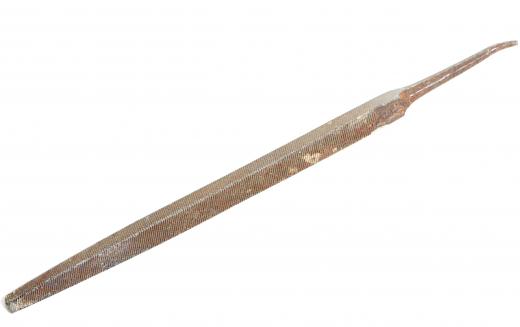A sharpening jig is a device used by woodworkers to sharpen metal tools. Over time, tools can wear out or develop dings along the edges. While sharp tools produce clean cuts and give users maximum control over work quality, dull tools may split the wood or make work more difficult. Rather than take these tools to a professional sharpener, many craftsmen sharpen these tools at home. A sharpening jig helps hold the tool at a precise angle during sharpening, resulting in a more precise and consistent finish.
Woodworkers may use a mechanical grinding wheel or sanding stone to sharpen metal tools. Different types of sharpening jigs are designed to work with either of these two sharpening methods. While commercial jigs are available, many users prefer to make their own jigs out of wood or other materials. A sharpening jig may be designed to push the length of the blade along a wheel or stone, or to run the blade side-to-side over the stone or wheel. The choice between these two designs depends largely on the type of tool being sharpened and how it is configured.

Each sharpening jig consists of a wood or metal body and a clamp to hold the tool or blade in place. Depending on the design, it may also feature a clamp or clip used for fastening the jig to a grinding wheel. The jig holds the tool or blade at a specific angle, which allows the user to maintain uniform angle between this tool and the grinding wheel or stone. By using the same jig each time, users can replicate a cutting angle to ensure consistent results.
These jigs offer a number of advantages to new and experienced woodworkers alike. A sharpening jig teaches new users the correct angle to use when sharpening a tool, allowing them to achieve the desired cutting angle on the blade. It also helps the user achieve the same angle each time the tool is sharpened. Since workers often get used to the nuances of their tools, this consistency makes it easier to use tools correctly and achieve quality results. Consistent angling or beveling also helps to extend the life of a tool by reducing metal lost to bad sharpening techniques.
One potential drawback to using a sharpening jig is the potential safety risks involved. Using a jig while sharpening tools makes it easy to lose focus on the task at hand. This could lead to injuries or broken tools. It is also critical for users to use the correct jig size for each tool. Using a jig that's too small to hold a tool securely could allow the tool to fly away from the grinding wheel, leading to injury.
